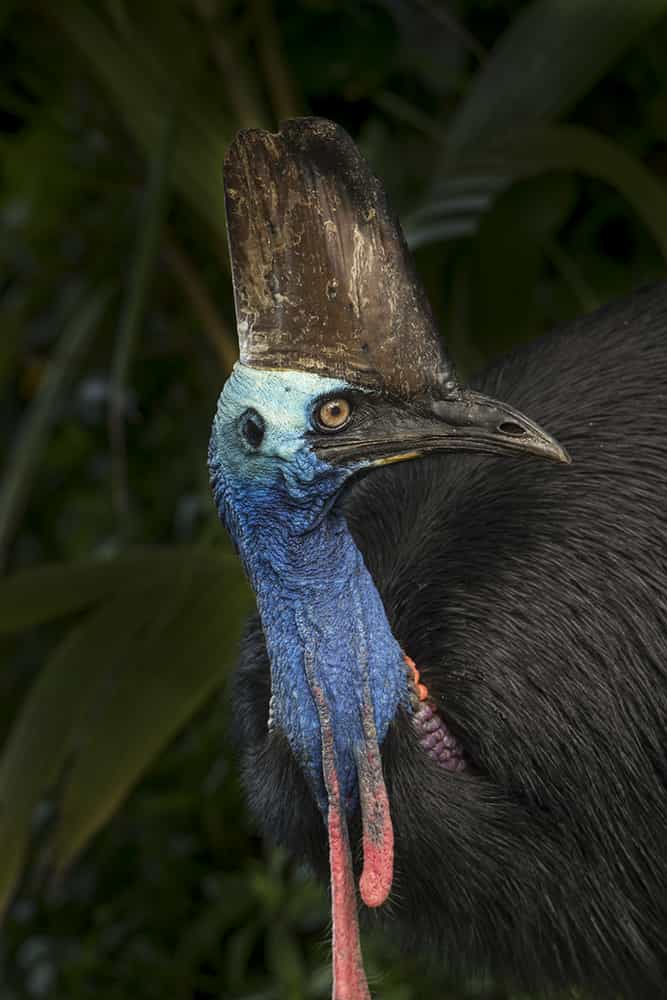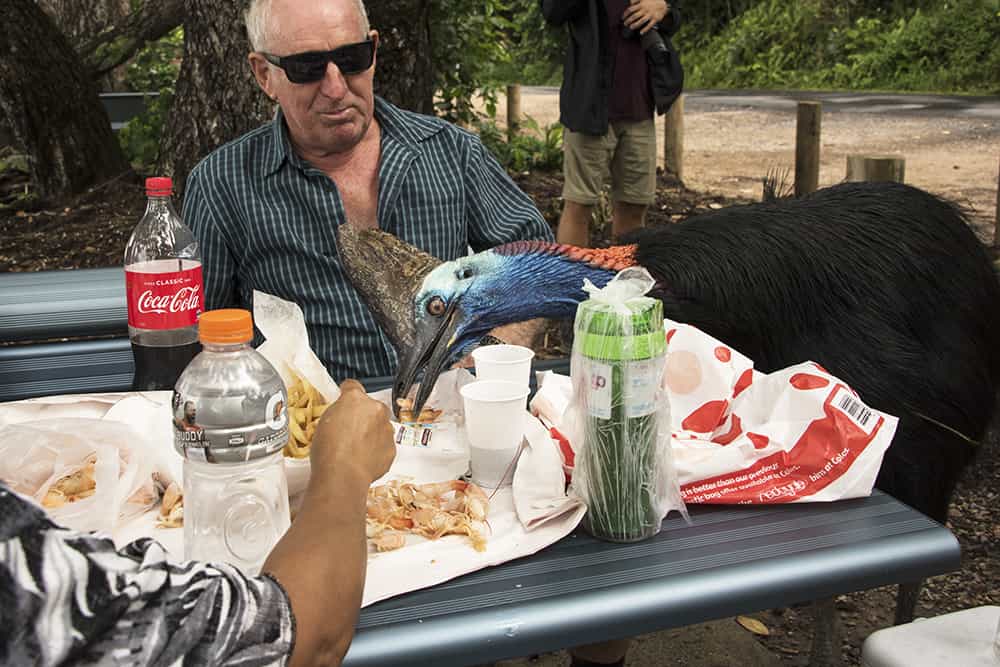Jungle royalty: the enigmatic cassowary

THE WORLD’S SECOND-heaviest bird remains shrouded in mystery. Living in the shadowy world of northern Queensland’s ancient rainforests, the southern cassowary still sometimes surprises scientists and wildlife carers with unusual and rarely documented behaviours.
For example, there’s the question of diet.
Although cassowaries mostly eat fruits and seeds, they occasionally add a little protein from fish, crustaceans and even roadkill, says Wren McLean, an ecologist and conservation scientist with the Rainforest Trust in Mullumbimby, northern New South Wales. “They are known to go fishing by lowering themselves into a freshwater pool and opening up their feathers. They allow the small fish to come in and eat their dead skin cells,” says Wren, whose cassowary survey work has been supported by the AG Society. “Then they close their feathers, step out of the water, shake themselves and pick up the little fish.”
Dr David Westcott, a CSIRO zoologist based in Atherton, Queensland, who has studied cassowaries for many years, agrees “the different strategies they use to get a balanced and non-poisonous diet are interesting”. Being almost entirely frugivorous (fruit-eating) can be difficult, because many basic nutrients are poorly represented, so cassowaries “have to really be quite clever”, he says. To this end, cassowaries have been seen eating road-killed bandicoots, while the remains of crabs and even small birds have been found in cassowary faeces.
Being almost entirely frugivorous (fruit-eating) can be difficult, because many basic nutrients are poorly represented, so cassowaries “have to really be quite clever.”
Ingrid Marker, a long-time wildlife carer at the Garners Beach Cassowary Rehabilitation Centre, run by Rainforest Reserves Australia, has been in almost daily contact with cassowaries for about three decades and has also seen several unusual behaviours. On one occasion, she saw a chick make a vocalisation that she believes indicated a hawk in the sky above. “The male looked up and then puffed himself up like a pufferfish, and the chicks ran underneath him, and they walked back into the canopy,” Ingrid says, adding that cassowaries have a series of different calls for different threats.

(Image credit: Justin Gilligan)
Elusive nature makes them difficult to study
Because cassowaries spend most of their time in dense forest away from the prying eyes of researchers, it is not surprising that we still know so little about them. “For a huge bird with bright colours, they only need to take a few steps off the road into shady rainforest and you can’t see them,” Wren says. “They are difficult to spend time observing and studying.”
The bird’s elusive nature has also made it difficult to accurately assess the species’ population size. The first comprehensive survey in the Wet Tropics of Queensland – a World Heritage area that stretches from just south of Cooktown to almost Townsville and represents the core of the cassowary’s range in Australia – was carried out by a team of CSIRO scientists led by David and published in 2014.
The researchers collected DNA from scats to extrapolate the number of individual birds in the region and the results surprised everyone by revealing a population of up to 4500 cassowaries. This was great news, because some earlier estimates suggested as few as 1500 were left. “We had the numbers really wrong,” Wren says. “We were actually very pleased.”
In 2017 the revised estimate led to the species conservation status being downgraded from Vulnerable to Least Concern on the IUCN Red List. Both Wren and David have been involved in recent surveys on Cape York Peninsula, working alongside traditional-owner groups. While most of Australia’s cassowaries live in the Wet Tropics, there are several smaller, little-studied populations in isolated rainforest pockets further north.
The southern cassowary is also found in New Guinea (alongside the northern and dwarf cassowary species), where the population numbers 15–45,000 and suitable habitat covers an area about 15 times that in Australia.
To learn more about cassowaries in Cape York’s McIlwraith Range, 450km north of Cairns, Wren created visual lures – fake rainforest fruits – to attract cassowaries to camera traps. The images helped her identify individuals and also captured previously unseen behaviours in both chicks and male–female pairs.
Cassowaries are culturally important for many far north Queensland Aboriginal groups, including the Ayapathu, Kaanju, Lama Lama, Umpila and Wik-Mungkan of the Coen region of Cape York Peninsula; and the nine Indigenous groups represented by the Girringun Aboriginal Corporation, whose lands lie between Mission Beach and Townsville. Several of these groups are now involved in cassowary conservation, using traditional ecological knowledge in concert with modern science.
Known as Kutini to the people around Coen, and Gunduy or Gundulu to some groups further south, cassowaries are integral to Dreamtime narratives and traditional lore, and feature in stories, ceremonies and dances. Cassowaries were also once a valuable food source and played an important role in rainforest seed dispersal, helping to ensure a constant supply of new fruit for people to forage.
Tim Jaffer, executive director of Kalan Enterprises, which represents traditional owners around Coen, says that when they began to think a decade ago about how best to manage the land recently returned to them, one focus was the rainforest uplands of the McIlwraith Range.
“It’s where the creeks come from and the rivers flow out of that [to] join the country up,” he says. “Lots of bush materials are collected in the rainforest and there’s lots of wildlife there and cultural stories associated with those animals. The southern cassowary is one of them.”
Working alongside scientists such as David, Kalan rangers have been involved in 15 or more field trips over six years that have provided an estimate of 170–400 cassowaries in the range. Some of the biggest threats here are climate change, uncontrolled bushfires, feral cattle and pigs. “Feral cattle spoil waterholes and we know that cassowaries need water to cool down in the top of the dry season,” Tim says.

(Image credit: Justin Gilligan)
Vehicle strikes and dog attacks an issue
Further south, in the Wet Tropics, the conservation challenges are different. Here the birds are killed in significant numbers by vehicle strikes and dog attacks. Ingrid says that in the past two years alone, she has responded to 18 reports of cassowaries mauled by dogs around Mission Beach. She’s often unable to recover a body, so the true scale of the problem doesn’t figure in official statistics. There’s a culture, she says, of owning aggressive dogs for hunting feral pigs and “putting them in your ute to go running around on a Friday and Saturday night is a huge recreational pastime”. Dogs are sometimes let loose in cassowary habitat, although it’s illegal, and “any animal that happens to get in their path is often preyed upon”.
There’s a culture, she says, of owning aggressive dogs for hunting feral pigs and “putting them in your ute to go running around on a Friday and Saturday night is a huge recreational pastime.”
However, most adult cassowaries that come into care at the rehabilitation centre, which can house up to 18 birds, have been hit by cars. If one is struck at 50km/h it has a good chance of surviving, Ingrid says. But those hit by cars doing 100km/h have almost no chance. Juveniles and chicks orphaned through dog attacks, some just 2–3 days old, are also commonly admitted.
The last time the facility was inundated with injured and sick birds was following Cyclone Yasi in 2011. “There wasn’t a leaf on a tree, and if the cassowaries survived the falling of the debris then they were subjected to starvation,” Ingrid says.
“In a natural situation, they could have walked from the coast up into the mountains, where there’s still plenty of fruit around, but in the fragmented landscape in which they now live they can’t move across country.”
Most of the centre’s birds are released once they’re healthy. Because of habitat fragmentation, carers are cautious about release locations. These need ample food and water and no other cassowaries, because they’re solitary animals and very territorial. Local traditional owners and the scientists are often consulted.
At the centre, human contact with the birds is minimised. Young cassowaries are fed a wide variety of fruits, hidden in their enclosures to make them challenging to find. Carers hope the birds’ instinctive behaviours will be strong enough for them to forage successfully once released. “In reality, they aren’t going to be as comfortable in the wild or as knowledgeable as a wild bird,” David says. “So they’re always going to be at a bit of a disadvantage, and we don’t have a good understanding of how well they do after release.”
Ingrid says one reason cassowaries get hit by cars is they’re in no hurry to get off the road. “People think they are stupid,” she says. “[But] what they are is arrogant. They are the queens of the jungle and don’t move out of the way for anybody.”
Females are particularly assertive and territorial, Wren says. She once climbed a tree, heart pounding, to escape one intimidating her. These intelligent birds are highly attuned to anything going on within their realm, she adds, telling the story of being slowly escorted out of a cassowary’s territory during survey work: “I was walking along a river and she was walking behind the vegetation, 10m behind me, calling regularly. When I crossed the river, she came out of the foliage and stood there staring at me for ages.”
David says peacefully observing a cassowary at a distance as it goes about its daily activities is a wonderful experience: “A bird has tolerated my presence for hours on end on a few occasions and it’s always a really peaceful and privileged feeling.”
This article was first published in Issue 152 of Australian Geographic.




